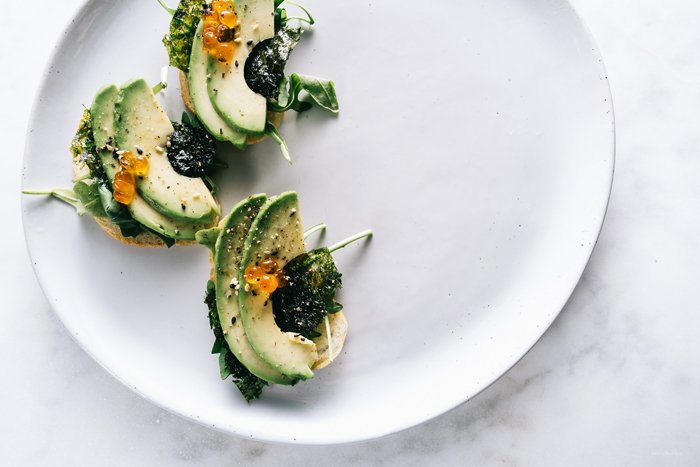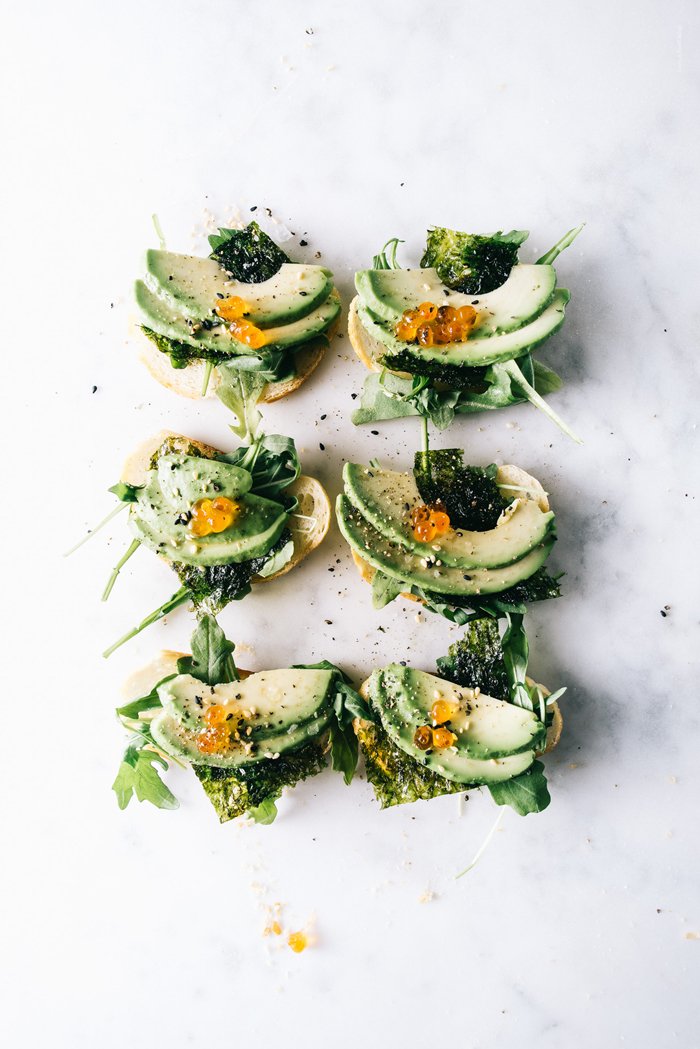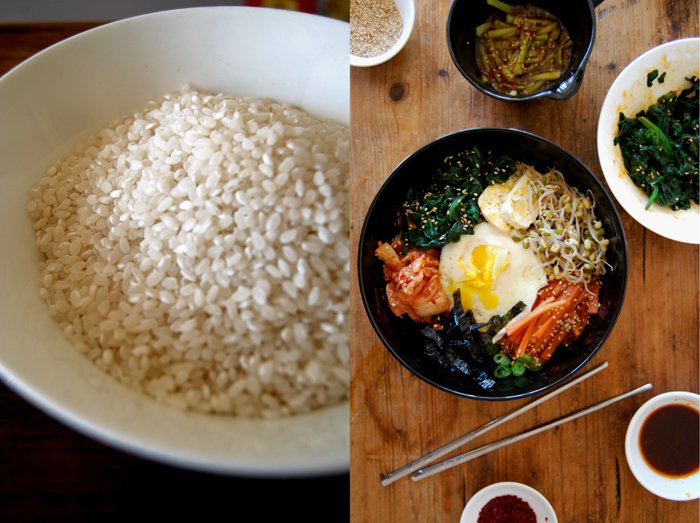meet in your kitchen | Stephanie Le's Japanese Inspired Avocado Toast
When I started my blog back in November 2013, I didn't really have much of an idea of what was going on in the food blog scene. It was all new to me and I was curious to see what it would be like to write about my food and share a recipe every day - my chosen task for the first 12 months of blogging. So in the beginning, I focussed a lot on my own work, but then, in the cold early days of 2014, I began to discover more and more bloggers, their approach to food, their recipes, and their style of writing. It was a whole new world to me. And when I saw the food photography on some of these pages, I knew I had to improve considerably behind the camera!
One of those blogs caught my attention at first sight. I Am A Food Blog is written by Stephanie Le from Canada. Her dishes sound and look delicious and the photography is just stunning. It didn't surprise me in the least bit that she published her first cookbook, Easy Gourmet, in the same year I 'found' her. There are three things that strike me in Stephanie's work: Her easy way of cooking - it's not fussy at all - her unique, clean style of presenting her creations, and the fact that the world meets in Stephanie's kitchen. You can find Canadian classics next to Chinese, Japanese, British, French, or Mediterranean dishes. It's all comfort food, it's all yummy, and, most of the time, it's relatively quick and easy to prepare. The young cosmopolitan woman likes to travel the world, literally, but also in her cooking.
Camping is one of Stephanie's latest, re-discovered travel adventures and her Camp One Pot Beef Stroganoff leaves no doubt that she's a pro in the wilderness. The recipe she shared with me would also be a great snack for this lonely life, out in a tent, unplugged and cut off from civilization: A Japanese inspired Avocado Toast. For those days when even a camper needs a special treat.
Japanese Inspired Avocado Toast
This toast is perfect when I have a sushi craving but also want avocado toast. I love a crunchy toast base and the roast-y saltiness of laver pairs perfectly with creamy avocado. The salty ikura are tiny pops of brightness and the sesame seeds add a bit of nuttiness. Seriously good!
Makes 10-12 toasts
avocado 1
toast or baguette 10-12 thin slices
baby arugula 1 handful
laver (roasted seaweed) 6 pieces
ikura (salmon roe) 1-2 tablespoons (leave out the roe for a vegetarian version)
toasted white and black sesame seeds
salt
ground pepper
Place the avocado on a cutting board and cut lengthwise, in the middle carefully, rotating around the seed. Twist half of the avocado off and remove. Place the remaining half (with the pit) on a dish towel and carefully tap your knife into the pit so that it wedges itself in. Twist the knife and remove the pit. Place the avocado, cut side down on to your cutting board and peel off the skin. Cut into 10-12 thin slices.
Top slices of toast with arugula, half a piece of laver, 2 avocado slices, a bit of the ikura, sesame seeds and salt and pepper to taste. Enjoy!
When did you start your food blog I Am A Food Blog? What got you hooked on writing about food and recipes?
My husband and I started I am a Food Blog in 2012 – it was after our other food blog, where I cooked through the entire Momofuku cookbook. Cooking through Momofuku is where I learned to love blogging – taking the photos, working through recipes, and sharing stories.
You just started a camping series on your blog. What do you love about camping? What are your favourite camping spots?
Camping is just fun – it’s always hard for me to unplug and stay away from the internet. I’m pretty much addicted. So camping is a fun (and enforced) way to take a break from the internet. My husband and I hike, sit around the fire, have heart-to-hearts and generally appreciate nature. We love camping along the West Coast – all of the National and State Parks in the US have really nice sites, but they book up fast.
Can you give us some catering tips for life in a tent?
Cooking while camping isn’t really a wing it sort of thing, so make sure you’re prepared. Make a list and check it twice! I like to measure out ingredients before hand and I also like to collect tiny condiments (like tiny ketchup packets) so I can bring them along. It’s best to also consider cooking fuel – recipes that don’t take a long time to cook are best.
Which city in the world inspires you the most when it comes to food culture and why?
I love Japan and Japanese food, so I’d have to say Tokyo. And the beauty of Tokyo is that they have myriad of other types of cuisines too, so it’s very inspiring. I love their attention to detail.
You live in Vancouver, Canada, what do you like about Canadian food?
I love that Canada is multicultural. We have so many different people from different cultures here that there is a very diverse food scene, especially in Vancouver. I think everyone thinks of poutine (crispy fries topped with squeaky cheese curds and gravy) when they think of Canadian food and I have to say, I do love it. When I don’t have poutine for a while I definitely crave it. It’s a guilty pleasure.
You call your husband your chief taste-tester, do you also cook together with him?
Yes! We actually work on the blog together – he designed the site and takes photos as well. He’s actually the one who taught me to take photos. He doesn’t cook for the blog, mostly just for us, family and friends. He’s really good at things that take a long time, like soups and stews.
Did cooking and food play an important role in your family when you grew up? When did your love for the kitchen and its creations start?
I actually didn’t like food much when I was a little kid. I was super picky. Although I remember having a play kitchen that I was obsessed with. My mom gave it away when I was at school one day and I was devastated. My mom cooks a lot, both now and when we were little, so I think I learned my love for cooking from her, through osmosis.
What was the first dish you cooked on your own, what is your first cooking memory?
To be honest, I don’t remember what the first thing I cooked on my own was. I do remember baking cupcakes at day care, being extremely proud and bringing one for my mom to try.
You’re going to have ten friends over for a spontaneous dinner, what will be on the table?
It would definitely be a DIY type meal: maybe tacos, or Vietnamese vermicelli bowls, or build your own salad. Something like that. I like interactive meals where everyone can make things to their individual tastes.
What was your childhood culinary favourite and what is it now?
I loved cereal when I was a kid. I used to eat it exclusively. Now, it would be entirely too difficult to choose, I love so many things. I could never give up noodles, that’s for sure.
Do you prefer to cook on your own or together with others?
I would say I like cooking with others, but my husband wouldn’t agree (laughing). I do love collaborating, but maybe I’m not so good at it?
Which meals do you prefer, improvised or planned?
I like both! I like the casualness of improvised meals, but if I feel any sort of pressure at all, I will need to plan because I’m a planner. I think the best of both world would be having an extremely well stocked fridge and pantry so that I could improvise without constraints.
Thank you Stephanie!
Yu-Kyong's Bibimbap, a traditional Korean treat
A few weeks ago I met a very sweet couple from Norway, Lena and Knut, we sat opposite each other at a supper club and started talking. Days later I found out about their wonderful blog Teak Tray Weekdays where they share little treasures of their daily life in Trondheim and their traveling trips, I got peacefully lost in their stories. When Lena asked me if I would like to cook something together with them I was very happy. I liked the idea of the three of us cooking the same meal in different kitchens in different countries and with different recipes. I let them choose what we would cook and they suggested Bibimbap. They had just been to Berlin and enjoyed this Korean speciality at a restaurant so much that they wanted to cook it at home.
At first, I wasn't sure about my approach to this meal. I had never cooked Korean before and I usually need an experience, a memory, a story, taste, something that opens the door to a new culinary experience. I asked my oldest friend Yu-Kyong for help, we lived next to each other through our whole childhood, she has Korean roots, her father grew up in North Korea and her mother in the South. She lived in Germany all her life but her mother cooks Korean for the family and introduced her daughter to the traditional recipes, like Bibimbap.
When I asked Yu-Kyong to write down the recipe so that I could buy all the ingredients she told me that this wouldn't work, we would have to go shopping together. We met at an Asian market and she gave me an introduction to Korean cooking. She explained the necessary spices, mixtures, spice pastes and preparations to me, all in between hundreds of boxes, tins and bottles of food, freezers stuffed with tiny crabs, octopus and fish. The scent of a different world in my nose, visually overwhelmed, I tried to keep up with her. She told me about the different flavours and qualities of sesame oil, I learnt how to cook sticky rice properly, which cutlery I have to use (a metal spoon and metal chopsticks, not wooden!) and so much more. Basically, a one hour crash course on Korean cooking, in the middle of an Asian market, typing everything more or less precisely into my phone, not to forget a single detail.
I got home with bags of vegetables, Kimchi, roasted seaweed, Obok Gochujang hot pepper paste, many colourful tins and boxes. I bought the first tofu of my life and I felt happy and finally prepared for this new cooking experience.
Here's a quick description of Bibimbap, it's a one pot meal, rice at the bottom and steamed vegetables mixed with a sesame oil and soy sauce dressing on top. I steamed spinach, sprouts and carrots and added strips of seaweed, Kimchi (spicy fermented cabbage), fried tofu and eggs. The spinach is glazed with the special Bibimbap Gochujang sauce which is mixed into the rice as well. I made a traditional cucumber salad on the side, mixed with sesame oil and soy sauce, sprinkled with chili powder and toasted sesame seeds.
This meal needs good preparation before you mix everything together, it's a ceremony of pure tastes mixed with the strong flavour of good quality sesame oil and the spiciness of Gochujang. When you make your own Bibimbap you should allow some extra time to enjoy the cutting, steaming and mixing, it's meditative. I learnt that this is not a warm meal, the rice and egg (which I fried in the end) have to be warm but the steamed vegetables can be cold.
Vegetable Bibimbap and Cucumber Salad
For 3-4 people you need
sticky rice, rinsed, 170g / 6 ounces
soybean sprouts, steamed for 1-2 minutes, a handful
spinach, steamed for 1-2 minutes, 250g / 9 ounces
carrot, cut into julienne, steamed for 1 minute, 1-2
tofu, cut into 0.5cm / 1/4" slices, 200g / 7 ounces
Kimchi 6 tablespoons
spring onions, cut into thin slices, a small handful
Korean roasted seaweed, cut into strips, 5 sheets
organic eggs 3-4
sesame seeds, toasted in a pan for a couple minutes on medium heat, 2 tablespoons
cucumber, peeled, cut in half, without the seeds and soft parts, a 15cm / 6" piece for the cucumber salad
dried chili spice for the cucumber salad, 1/8 teaspoon
Gochujang hot pepper paste 1 tablespoon
sesame oil 6 tablespoons
soy sauce 5 tablespoons
sugar
garlic, crushed, 4 cloves
Whisk the following ingredients for the sauce used for the steamed soybean sprouts, carrots and cucumber salad
4 1/2 tablespoons of the sesame oil
3 tablespoons of the soy sauce
1 1/2 tablespoons of sugar
3 small crushed cloves of garlic
Whisk the following ingredients for the Bibimbap sauce (used for the steamed spinach and the rice)
1 tablespoon of the Obok Gochujang hot pepper paste
1 1/2 tablespoons of the sesame oil
2 tablespoons of the soy sauce
3/4 tablespoon of sugar
1 small crushed clove of garlic
Cook the rice in a pot filled with water and a pinch of salt (the water should be 2cm / 1" above the rice) for 12 minutes, on medium heat, keeping the lid closed. If the rice is still hard and didn't soak all the water, keep it on the heat for a couple more minutes. When it's done, keep the rice covered and set aside.
For the salad, cut the cucumber into strips, mix with 1/3 of the dressing (not the Bibimbap sauce) and sprinkle with some sesame seeds and the dried chili spice. The cucumber salad is served as a side dish, not on top of the Bibimbap like the rest of the vegetables.
Glaze the steamed soybean sprouts with 1/3 of the dressing (not the Bibimbap sauce) and the steamed carrots with the rest of the sauce, sprinkle both with sesame seeds.
Mix the steamed spinach with 4 teaspoons of the special Bibimbap sauce (keep the rest of the sauce to mix with the rice).
Fry the tofu in a little sesame oil for 2 minutes until golden, turn gently and fry on the other side. When it's done, set it aside.
Fry the eggs, leaving the egg yolk soft.
Put the rice in a large bowl and the spinach, carrots, sprouts, Kimchi, spring onions, tofu and seaweed on top, arrange them in a circle next to each other. Place the fried eggs in the middle and sprinkle everything with sesame seeds.
When you serve the Bibimbap at the table, you can either mix everything in the bowl together with the rest of the Bibimbap sauce or divide it between the plates and add some sauce to it (that's how I did it).














